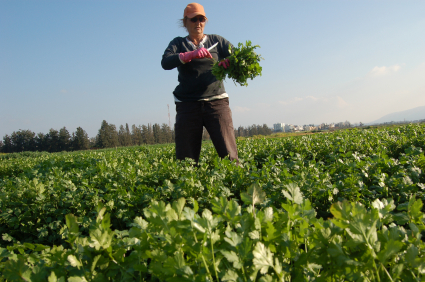
reference-image, l
(article, Jes Burns)
[%pageBreakSettings nobreak=true] A few months ago, I bought a two-pound plastic bag of basmati rice. I brought it home and eventually cooked my way through its last grains. Full of thrifty versatility, I then repurposed my resealable rice bag into a toiletries carryall, and proudly took it on a weekend trip to visit some friends. My friends found my choice of container amusing. “Nice rice bag,” one of them said. “Have you read it?” asked the other. “It’s crazy!” “Yes!” agreed my partner, who had apparently been reading my bag on the sly. “That’s the most eco-pious packaging I’ve ever seen.” I had never thought to read the bag’s labeling. “Eco-Farmed,” it proclaimed. “Always in Balance with Nature.” “We purchase green power.” “We practice water-conserving irrigation.” “We provide a valuable habitat for a variety of animals.” And so forth. Everybody, it seems, wants a piece of the sustainable-business pie; even Wal-Mart now sells organic produce. And if sustainability is the new religion, small-scale farmers are the prophets, worshipped at farmers’ markets and supported by community-supported agriculture (CSA) tithes. Independent farmers, as their books and magazines will tell you, are our guides in the search for authenticity, truth, and meaning via food. Michael Ableman’s Fields of Plenty: A Farmer’s Journey in Search of Real Food and the People Who Grow It, follows the cross-continental journey of a prophet in search of other prophets, validation, and answers to questions about how to transform food production into a model of sustainability. “This journey will take me to see those who are trying to answer these questions, not in some philosophical vacuum, but in ways that are real and practical and visible,” writes Ableman. “Are they making a difference? I don’t know, but I’m eager to find out.” Ableman’s travels take him to 25 different farms across Canada and the United States. As far as crops, products, or even agricultural practices go, the farms have little in common. But all the farmers Ableman visits are operating on the extreme edge of acceptable farming practices. From allowing weeds free rein in rows, to growing fruit trees from seedlings instead of grafts, to allowing crops to self-seed, the farmers he visits are pioneers looking both backward into our agricultural heritage and forward into a future full of farming practices that lessen our impact on the land. As people become more conscious of what they eat and how it’s prepared and grown, small-scale farmers gain a newfound primacy. Their farms become shrines for the eco-pious. Arguably, the one thing all farmers have in common is their attachment to, and quiet worship of, a piece of land. The farmers featured in Ableman’s book tend not to see their plots as a commodity or exploitable resource, but as a partner in a reciprocal relationship. Steward your land, and it will steward you. This farm/farmer symbiosis is at the heart of Farmer John’s Cookbook: The Real Dirt on Vegetables, by John Peterson and Lesley Freeman. In the introduction, Peterson (the eponymous Farmer John) writes that people are becoming aware that something is missing in the way they experience the food they eat. “Whatever their individual reasons, these people are embracing a movement that recognizes food in relationship to a specific piece of land and to a particular group of people,” writes Peterson. [%image farmergal float=left width=400 caption="Going green." credit="Photo: iStockphoto/Dorit Jordan Dotan"] Peterson’s team at Angelic Organics is in the business of community-supported agriculture. He acknowledges that for many consumers, establishing a relationship with your food — and in turn your farmer and farm — means giving up something seemingly bred into the American consciousness: choice. “Even though you’ve chosen to consume high-quality, local vegetables, your food selection is now dependent on new factors, like the farmer’s field plans, the farm’s climate, and the effects of weather on crops,” he writes. Most religions preach self-sacrifice and compassion; the eco-pious give up a degree of choice in order to be compassionate to the environment, and in turn, to every human on the planet. Despite the philosophical implications of the lifestyle Farmer John’s Cookbook promotes, the book reads as more of a how-to manual for your weekly CSA share. It compiles decades of farm wisdom and attempts to answer questions like, “What do I do with this much cabbage?” Books like Fields of Plenty and Farmer John’s Cookbook, which depict the small-scale farmer as the link between modern society and the way our food is produced, are part of a wider trend in food publishing. The magazine/catalogue MaryJanes Farm epitomizes this trend in the magazine world, offering community-building forums with regular sections called “Here for Life,” “Home Safe Home,” and “Farm Life with MaryJane Butters.” Food'n'farm blogs such as Farmgirl Fare and I Heart Farms offer a similar vision. And by summer at least two more books will be added to the subgenre: The Farmers' Market Book: Growing Food, Cultivating Community, and Women of the Harvest: Inspiring Stories of Contemporary Farmers. As the gospel of eco-piety spreads and the interest in food politics and sustainability increases, people will continue to seek out sources of knowledge: their local farmers. They will purchase and consume food with an eye towards righteous sustainability. And they will read the words of their prophets in books, magazines, CSA newsletters, and, occasionally, on a bag of basmati rice. p(bio). Jes Burns, a writer in Eugene, Oregon, dreams of owning a chicken trained to ride on the back of a cat trained to ride on the back of a sheep.

reference-image, l

feature-image, l

farmergal, l

featurette-image, l